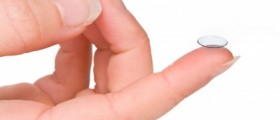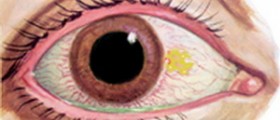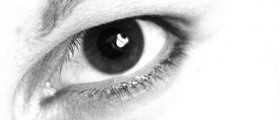
Corneal ulcers, also known as ulcerative keratitis or eyesores are inflammatory and sometimes infective conditions of the cornea. The cornea is the transparent front part of the eye that covers the iris, pupil and anterior chamber. The inflammatory condition usually involves disruption of the epithelial layer of the cornea and corneal stroma, fibrous, tough, unyielding and perfectly transparent tissue of the eye. Corneal ulcers usually appear as gray or white patches on the normally transparent cornea. This can be a very serious health concern and may permanently impair vision or perforate the eye. Corneal ulcers are considered an ophthalmologic emergency.
Causes of corneal ulcers
Corneal ulcers are most commonly appearing due to an infection. These ulcers are most frequent in people who wear contact lenses and they are usually caused by bacterial infections. Bacterial infection of the cornea can follow from an injury or from wearing contact lenses. Bacteria will invade the cornea and cause the ulceration of the area.
Other known sources of infection are viruses, namely herpes simplex virus and varicella virus. Fungal infections are also possible and they usually occur as a result of inappropriate care for contact lenses or overuse of eye drops containing steroids.
Not only people who wear contact lenses get corneal ulcers. This inflammatory condition of the eye is possible whenever there is a tiny wound or scratch in the corneal surface. The small cuts may result from a minor trauma that may strike the cornea, usually from metallic, wood, glass or any other type of particle that gets in the contact with cornea. Moreover, dryness of the eyes, a common problem among otherwise healthy people, drastically decreases germ-fighting properties of an eye, making an individual more prone to corneal ulcers.
Symptoms of corneal ulcers
In most patients, corneal ulcer causes redness, pain, tearing and a sensation of a foreign object in the eye. The vision is reduced and often blurry, accompanied with discharge draining from the eye. Some patients may feel pain when looking at sources of light. The eyelids may also be swollen. The ulcer may be central in the cornea or marginal, at the outer edge of the cornea. Often there is a swelling around the ulcer. Ulcers may appear on both eyes at the same time.
Treatment for corneal ulcer
The treatment depends on the exact cause of ulceration. When the ulcer appears due to an infection, doctors usually prescribe anti-infective agents, usually in the form of drops or ointments. Oral medications are administered whenever the viruses cause ulceration. In cases due to dryness or corneal exposure, doctors will prescribe tear substitutes. Contact lenses should be discontinued in any case of corneal ulcer.

















Your thoughts on this
Loading...